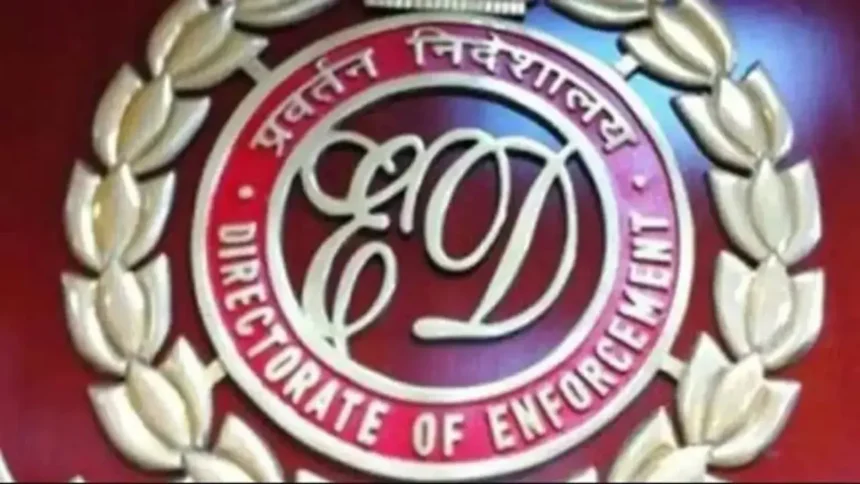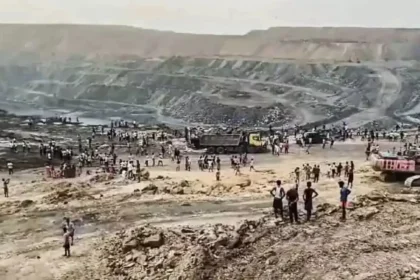Mithi River Scam: ED Raids Expose Multi-Crore Corruption in Mumbai’s Infrastructure Projects
The Enforcement Directorate (ED) has once again brought to the forefront the systemic failures and alleged corruption embedded within Mumbai’s civic infrastructure projects. In a development that has sent ripples across political and bureaucratic corridors, the ED conducted raids at eight locations across Mumbai as part of a money laundering investigation linked to the alleged Mithi River desilting scam. The targets of the raids include major contractors and entities engaged by the Brihanmumbai Municipal Corporation (BMC) for the river rejuvenation project, initially aimed at flood control and environmental restoration.
The Mithi River, once a vital natural drainage system for the city, has long suffered from pollution, encroachments, and mismanagement. The desilting and river widening project, launched post-2005 Mumbai floods, was touted as a critical effort to prevent future flood disasters. However, despite the allocation of hundreds of crores over the years, the river continues to overflow during monsoons, raising serious questions about the transparency, accountability, and execution of the project.
According to ED officials, preliminary findings suggest that large sums of money allocated for desilting and other related work were allegedly siphoned off through fake invoicing, subcontracting to shell companies, and manipulation of work measurement records. This latest probe under the Prevention of Money Laundering Act (PMLA) is part of a broader investigation into the misuse of public funds, where the focus is now shifting toward the contractors and middlemen involved, along with their possible political patrons.
In this multi-part article, we will examine the timeline of the Mithi River project, analyze the ED’s findings and raids, uncover the role of contractors and civic bodies, assess the environmental and urban planning impact, and explore the broader systemic issues of corruption and governance. This exposé aims to provide a detailed, transparent, and well-researched narrative that lays bare the real cost of corruption on urban development, public safety, and environmental sustainability.
The Mithi River has always occupied a peculiar space in Mumbai’s urban ecosystem. Neither revered like the Ganga nor entirely neglected like an industrial drain, the river was always just “there” — quietly absorbing the waste of a city constantly rushing forward. It wasn’t until disaster struck in July 2005, when monsoon floods devastated the city and drowned its infrastructure in knee-deep waters, that the Mithi finally commanded full-blown attention. Experts later blamed the river’s choked and constricted state as a major contributing factor. From that moment on, the Mithi River became a civic priority, at least on paper.
In the immediate aftermath, the Brihanmumbai Municipal Corporation (BMC) and Mumbai Metropolitan Region Development Authority (MMRDA) unveiled an ambitious plan: the Mithi would be rejuvenated. Widened. Desilted. Beautified. A modern retaining wall would prevent overflow. Illegal structures would be cleared. A river walk was even floated. What began as an environmental revival project soon transformed into a multi-crore urban development initiative that spanned over a decade and saw the sanctioning of hundreds of crores in public funds.
But while the documents projected progress, the river remained almost unchanged. Annual flooding in low-lying areas like Kurla, Kalina, and Dharavi continued. Complaints surfaced regularly about token clean-ups, hurried desilting work done just weeks before monsoon, and the reappearance of silt that had supposedly been “removed” the previous year. Citizens’ groups and RTI activists began asking questions: Where was all the money going? Who was monitoring the volume of silt removed? Were contractors truly held accountable?
By 2020, these questions grew sharper. RTI queries and audit trail gaps indicated mismatches between work claimed and actual on-ground conditions. Some silt removal figures bordered on the fantastical — lakhs of tonnes allegedly removed in just a few days by a handful of machines. Contractors continued to receive renewals and payments, despite repeated complaints about shoddy execution. NGOs such as the Mumbai Environmental Social Network (MESN) began documenting anomalies and submitting reports to state authorities.
In 2022, the Comptroller and Auditor General (CAG) flagged worrying lapses in oversight. Their reports hinted at possible inflation of work logs, absence of third-party verification, and a failure to properly measure the riverbed’s depth before and after desilting. Alarm bells rang, but accountability remained elusive.
It wasn’t until early 2024 that the Anti-Corruption Bureau (ACB) conducted a preliminary review. Their findings pointed to more than just inefficiency — they suggested fraud. Suspicious payment flows, duplicate invoices, and layered subcontracting models caught the eye of financial enforcement bodies. In 2025, the Enforcement Directorate (ED) officially stepped in, launching a full-scale investigation under the Prevention of Money Laundering Act (PMLA).
What began as a civic clean-up project had now morphed into a financial crime investigation, and the implications were massive. Not only was public money potentially looted, but the neglect also directly endangered millions of Mumbai residents who rely on the Mithi to manage monsoon runoff each year. As ED officials raided multiple contractor premises in Mumbai’s western suburbs, they recovered troves of documents, forged work logs, and possibly even links to benami shell firms.
The anatomy of the alleged Mithi River scam reveals more than just incompetence; it paints a picture of systemic fraud, bureaucratic connivance, and deeply embedded corruption that spanned multiple civic bodies and private entities. The money trail unearthed by the Enforcement Directorate (ED) does not stop at inflated contracts or missing invoices — it penetrates a vast web of dummy firms, shell entities, and circular transactions that, on the surface, looked legitimate but were, in essence, elaborate laundering channels.
The Overbilling Strategy
At the core of the scam was a simple yet effective mechanism: overbilling. Contractors hired by the Brihanmumbai Municipal Corporation (BMC) and Mumbai Metropolitan Region Development Authority (MMRDA) for desilting and riverbed clearing reportedly filed grossly exaggerated work reports. For example, invoices showed that thousands of metric tonnes of silt were removed in a few days using minimal manpower and equipment. Independent audits later revealed that either the silt had never been removed or that far less was actually excavated.
These inflated quantities were then used to generate bills, which were duly cleared and paid — sometimes in advance — by civic officials. In several cases, measurement logs and geo-tagged photo evidence were missing or falsified. Satellite imagery and on-ground comparisons by whistleblower groups starkly contradicted the official claims.
Circular Payment Routes and Shell Firms
The ED’s investigation revealed that once funds were released to the contractors, they were swiftly redirected through a maze of subsidiary firms and proxy accounts. Some of these shell companies, it is believed, were registered under the names of relatives, office peons, or completely fictitious identities. This layering of financial transactions allowed large sums to be withdrawn as clean, untraceable cash or routed into real estate and benami investments.
In one telling case, a contractor billed over ₹7 crore for silt removal work in 2023. Within 48 hours of receiving the payment, the entire amount was transferred to three obscure firms registered in Andheri East, each of which had zero employees and no physical office presence. From there, portions of the funds were traced to luxury car purchases, overseas transfers, and real estate deals in Navi Mumbai and Pune.
Lack of Third-Party Auditing
What made this financial operation even more effective was the complete absence of robust third-party auditing mechanisms. Though agencies like IIT-Bombay and NEERI were nominally engaged for environmental monitoring, the physical verification of desilting volumes and silt disposal was left to internal engineering departments — often the very people who sanctioned the contracts. This conflict of interest allowed the racket to continue unchecked.
There was also a failure to implement GPS tracking and RFID-based silt dumping logs, technologies that had already been suggested in earlier audits. This allowed the same truckloads of silt to be counted multiple times, a trick common in other infrastructure scams across the country.
Fake Manpower Rosters and Ghost Labor
Another common tactic was the invention of ghost labor. Several contractors submitted inflated rosters showing large teams of workers assigned to desilting operations — in some cases over 200 daily wage earners. However, on-the-ground checks showed fewer than 30-40 workers present. Wage slips and payment registers were either forged or incomplete, and many of the Aadhaar numbers listed in wage records were duplicates.
This allowed contractors to pocket the “unpaid” salaries of these non-existent laborers, all while claiming compliance with BMC’s labor welfare mandates. Several of these fake rosters were recovered during ED raids and are now part of the case file under the Prevention of Money Laundering Act (PMLA).
The Role of Civic Officials
While contractors executed the fraud on the ground, they could not have done so without help from within. Investigators believe mid- to senior-level civic officials played a key role by approving inflated work reports, overlooking auditing anomalies, and expediting payments despite obvious red flags. In several cases, kickbacks were allegedly routed back to these officials, either through hawala transactions or in-kind payments like gold, vehicles, or land.
Insider sources have hinted that some BMC engineers received cash “incentives” amounting to 2–5% of each processed invoice. Whistleblower accounts also suggest that a parallel payment system existed where contractors routinely “reserved” a portion of project funds as “departmental facilitation costs.”
If the financial web of the Mithi River scam was sophisticated, the political shielding that enabled it was even more deeply entrenched. The scandal has exposed not only structural failures in civic oversight but also long-standing relationships between contractors, municipal officials, and political figures. What was once whispered in bureaucratic circles as “routine commissions” has now emerged as a state-enabled, politically protected network of corruption.
The Invisible Hand: Political Patronage
Sources within the Enforcement Directorate (ED) believe that the most powerful force enabling the scam was not the contractors or the civic engineers—it was the politicians who turned a blind eye or actively intervened to shield those involved. This was not an isolated case of localized corruption. Rather, it was part of a broader ecosystem of political patronage, one that rewards loyalty and silence more than competence or integrity.
Multiple contractors who were awarded tenders for Mithi River cleaning reportedly had long-standing ties with political leaders across party lines. These relationships weren’t always visible through official meetings or financial disclosures—but they came alive during election campaigns, corporate donations, and backdoor lobbying.
In fact, several of the companies under the scanner for the Mithi River contracts have also been major contributors to political party funds, either directly or via affiliated trusts. These financial “contributions” often led to preferential treatment in tender allocation, and in some cases, pre-decided bidding where only a few “trusted” contractors participated.
The Role of Local Corporators and MLAs
The local corporators and Members of Legislative Assembly (MLAs) who represent the constituencies around the Mithi River were, by design, expected to monitor progress, inspect the site work, and escalate lapses. But ED investigators and RTI activists claim that many of these public representatives acted as intermediaries rather than watchdogs.
Numerous reports suggest that corporators lobbied for specific contractors, exerted pressure on BMC departments to clear invoices without proper inspections, and even received a share of the inflated budgets. In one telling example, a corporator from the western suburbs reportedly held unofficial weekly meetings with the project team to “review” the progress—meetings that were later described as deal-making sessions for profit-sharing.
The scam, therefore, wasn’t just a case of bureaucratic failure. It was a manifestation of a political-business-bureaucratic triangle, where each arm shielded the other for mutual benefit. This triangle is not new in India, but its exposure through the Mithi River case has reignited debates on the deep decay of local governance.
Deliberate Loopholes in Tender Norms
Much of the scam hinged on loopholes in tendering processes. While official guidelines mandated open bidding, there were systemic irregularities in pre-qualification norms. Several tenders were awarded to firms with no prior experience in river or drainage works, while more competent firms were arbitrarily disqualified over technicalities.
What’s more, the same set of contractors were often given work under different consortium names, effectively monopolizing the river work by floating multiple bids under different firms controlled by the same group. This was made possible because the vetting process was often carried out by civic committees heavily influenced by political leaders, many of whom had personal or financial interests in seeing these contracts through.
Why Whistleblowers Went Silent
Over the years, several internal whistleblowers within BMC and the MMRDA attempted to raise red flags about the irregularities in desilting operations and fund allocations. But most of them were either transferred, silenced, or simply ignored. In some cases, anonymous complaints were submitted to the Lokayukta and the Anti-Corruption Bureau (ACB), but the lack of political will ensured these complaints never moved beyond preliminary inquiry.
Even when citizens’ groups demanded real-time updates on Mithi River cleaning and expenditure data through the Right to Information (RTI) Act, responses were vague, incomplete, or delayed indefinitely. This culture of suppression not only allowed the scam to grow unchecked but also bred cynicism among honest officials.
ED’s Challenge: Piercing the Political Veil
As of now, the ED’s investigation is primarily focused on contractors and select BMC engineers. But multiple internal reports suggest that the probe may soon move towards questioning high-profile political figures, particularly those who were in power during the awarding of tenders from 2020 to 2023.
This is likely to be a sensitive and high-stakes phase of the investigation, as any direct evidence against political patrons could provoke institutional pushback or attempts to derail the inquiry.
However, public pressure, especially from civic groups, environmentalists, and social media activists, is pushing for greater transparency. If the ED can withstand political pressure and follow the money trail objectively, the investigation could become a watershed moment in Mumbai’s civic accountability history.
Ecological Cost — The Forgotten Victim of the Scam
While much of the public discourse surrounding the Mithi River Scam has focused on financial misappropriation and political complicity, one critical casualty of this nexus has been the ecological integrity of the Mithi River itself. Often dismissed as an urban drain rather than a natural river, Mithi’s degradation is both the symptom and the consequence of systemic neglect, monetized corruption, and short-sighted urban governance.
A River Turned Sewer
The Mithi River, once a vibrant tidal watercourse supporting local communities and biodiversity, now functions more as a conduit for industrial effluents, untreated sewage, and solid waste. The large-scale desilting and cleaning efforts funded through municipal budgets were meant to reverse this degradation. Instead, as the scam revealed, much of this funding was siphoned off, and superficial cleaning replaced meaningful restoration.
Satellite images and hydrological studies commissioned by independent environmental watchdogs indicate that the river’s carrying capacity has not improved despite multiple rounds of cleaning contracts and crores of rupees spent. In fact, in some stretches, the riverbed has narrowed further due to accumulated silt, encroachments, and illegal debris dumping.
Worsening Flood Risk and Climate Vulnerability
One of the most damaging consequences of the scam is its direct impact on urban flood management. The Mithi River was intended to act as a natural stormwater outlet during Mumbai’s heavy monsoon season. However, due to choked channels, encroached banks, and poorly planned infrastructure, floodwaters no longer drain efficiently.
The results are visible during every monsoon: waterlogging, traffic paralysis, property damage, and even fatalities in low-lying areas such as Kurla, Bandra-Kurla Complex (BKC), and Saki Naka. These aren’t merely acts of nature but outcomes of human greed and administrative failure.
The 2005 Mumbai deluge that claimed over 1,000 lives was a wake-up call. Post-disaster reports emphasized restoring the Mithi River to mitigate future risks. And yet, nearly two decades later, the ED investigation confirms that funds meant for this critical mission were looted, not used for long-term flood prevention.
Loss of Biodiversity and Natural Ecosystems
The Mithi River basin was once home to a rich ecosystem of mangroves, mudflats, migratory birds, and aquatic life. Many of these species have disappeared, displaced by encroachments, effluents, and land reclamation. Surveys conducted by the Maharashtra Pollution Control Board (MPCB) between 2018 and 2023 observed dangerously low dissolved oxygen levels, confirming the river’s inability to sustain life.
Environmentalists argue that the contractors, instead of employing ecologically sound desilting techniques, used aggressive mechanical dredging, destroying riverbanks and aquatic habitats. In several cases, mangrove buffers were either trimmed illegally or destroyed entirely, violating CRZ (Coastal Regulation Zone) norms.
Despite repeated interventions by the Bombay High Court and the National Green Tribunal (NGT), there has been no sustained ecological restoration. The ED’s raids and forensic audits now confirm why: a significant portion of the funds meant for ecological revival were falsified through paper work and ghost work orders.
Impact on Urban Heat and Microclimate
The degradation of the Mithi River has also had subtle but far-reaching consequences on Mumbai’s microclimate. The river’s natural ecosystem, including vegetation, wetlands, and water bodies, once acted as temperature regulators and carbon sinks. Their destruction has contributed to higher urban heat island (UHI) effects, especially in rapidly developing zones like BKC.
Urban planners and climate scientists have long advocated for the integration of natural water systems into urban infrastructure, but the Mithi River has been treated as a liability, not an asset. Ironically, it is the very destruction of this asset through greed and inefficiency that is compounding Mumbai’s climate risks.
The Way Forward: Restoration or Abandonment?
In the aftermath of the scam, many voices are calling for a comprehensive ecological audit of the Mithi River project, separate from the financial and legal investigations. Experts from IIT Bombay and international climate bodies are proposing a multi-disciplinary task force that can realign the restoration efforts with scientific principles and climate goals.
Such restoration, however, requires not just technology and funding—but political will, transparency, and long-term commitment, all of which have been missing thus far.
The future of the Mithi River, and by extension the resilience of Mumbai, depends on how this moment of reckoning is handled. Either the river continues to be exploited in the name of development, or it is reclaimed as a public ecological asset.
Also Read : War Strategy Shift: Russia’s Summer Offensive Escalates Conflict in Ukraine








